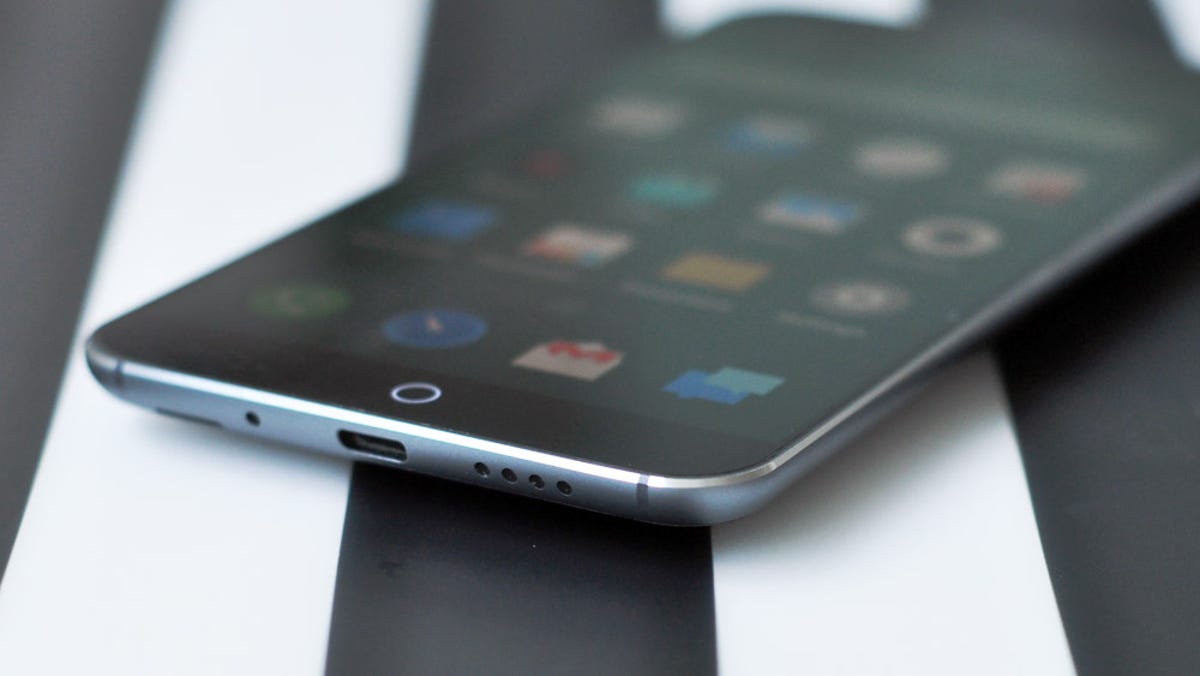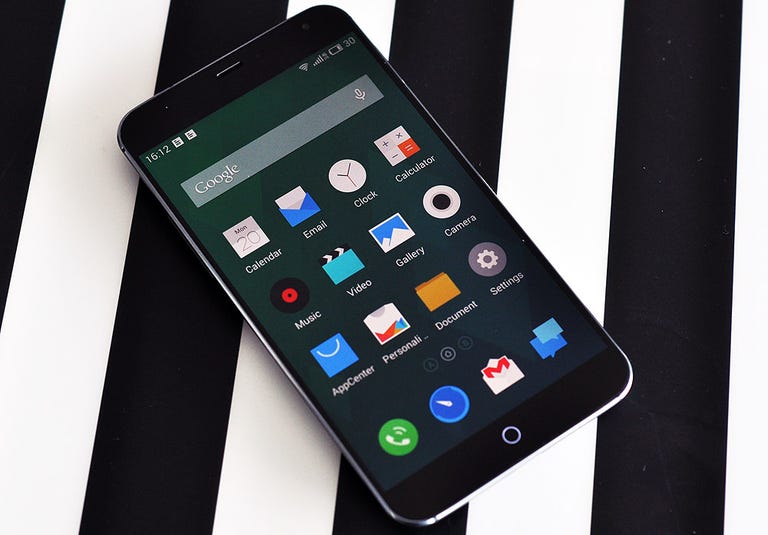 Why You Can Trust CNET
Why You Can Trust CNET Meizu MX4 review: Meizu's beautiful hardware is marred by buggy software
Meizu's latest phone has a gorgeous design and an interesting 5:3 display, but is let down by its flawed Flyme user interface.
Unlike more established Chinese brands such as Xiaomi or OnePlus , you've probably never heard of Meizu. The Beijing-based company has been building smartphones for a while now, and the MX4 is the company's fourth device -- and quite a stand-out it it too, with a unique 5.4-inch display with a 5:3 aspect ratio, much squarer than most phones.
The Good
The Bad
The Bottom Line
Inside, however, the story is more troubling. Battery life and camera quality are disappointing and operating system is riddled with bugs. Also, while the MX4 comes with 4G LTE connectivity, it isn't compatible with networks in the US. It should, however, be compatible with high-speed networks of both EE and Three in the UK and Optus in Australia.
Available at online retailers such as Gearbest in the US, the MX4 costs $449 for the 16GB model and $489 for the 32GB version. It's available via Amazon in the UK for £300 for 16GB or £304 for 32GB (why would you buy the 16GB one?). Australians will have to import the phone, with the US prices converting to AU$510 and AU$555, respectively. At this point, however, there are too many niggling problems to recommend it at that price.
Design
Sporting an Apple-inspired design, the MX4 looks just like a smaller iPad. Meizu has even added a circular home button on the front that hints at Apple's Touch ID buttons. The button isn't a fingerprint sensor, but it does light up like an arc reactor to alert you to notifications.
Turn the MX4 on its side to see even more evidence of the Apple influence. The edges are chamfered like the iPad Air , but the rounded edges have a plastic lining like the iPhone . On its backside, a curved plate makes the MX4 comfortable to hols. Unlike the glossy design of the MX3 , the MX4 goes for a matte grey color, darker than Apple's devices. Underneath the removable cover, there's a non-removable 3,100mAh battery, and a slot for the SIM card.

Instead of your usual smartphone display with a 16:9 aspect ratio, the MX4 has a strange 5:3 ratio and a resolution of 1,920x1,152 pixels crammed into its 5.4 inches -- slightly more than a full HD screen. It's certainly unexpected, but the execution is poor. It doesn't work well on the MX4 -- but more on that in a minute.
On the upside, viewing angles were great and colors were vibrant. The screen is bright enough to use outdoors under sunlight. The only thing I had an issue with was that the phone sometimes didn't quite seem to adjust correctly to the amount of light in the area, and ends up being a shade too dim. You'll have to manually tweak it instead.
I don't really see the 5:3 screen as something that really sells the phone -- at least not for me. There doesn't seem to be any extra usefulness compared with your standard full-HD display. My colleague Lynn La had similarly mixed feelings about the LG Vu's similar 4:3 aspect ratio .
Hardware
While most flagship phones run on Qualcomm's high-end Snapdragon chips, the MX4 takes a different route with MediaTek's MT6595, an octa-core processor that features four Cortex-A17 cores clocked at 2.2GHz and four Cortex-A7 cores clocked at a slower 1.7GHz. For gaming, the MX4 sports a PowerVR G6200 GPU.
For imaging, the MX4 has a rear 20.7-megapixel camera and a 2-megapixel front camera for taking selfies.
Software features
Powered by Android 4.4.4 KitKat and running a custom UI called Flyme 4.0, at first glance the MX4 seems capable of offering a unique experience not found on other Android phones.
For one, instead of having only software or hardware keys, the MX4 has a mix of both, the aforementioned circular button for home, and a soft key for back. To access the multi-app window, you just need to swipe up from the bottom of the display.
In theory, this sounds interesting, but in practice it's terribly flawed. Most apps aren't scaled for the display's 5:3 aspect ratio, and the menu button is often missing unless you rotate the phone to landscape mode, which then gives it a little more space at the sides for it to show up.
One example is the hugely popular messaging app WhatsApp. Upon hitting the camera button to take a picture from within the app, you then get trapped in a loop if you don't actually want to take an image. The back button is missing, and hitting X after you press the shutter button returns you to the camera screen. This leaves you with no choice but to either take and send a picture to get out, or to completely shutdown and restart the app.
Another thing I dislike is the custom Flyme keyboard. I've been using the phone for a week now, and I still can't get used to the lack of auto-correct (though it has suggestions) and the odd way of keeping the numbers and signs in two different screens. So if you need to type in something such as "Word5!!!" you'll have to go from the keyboard to the numpad to the symbol section. This makes typing quite frustrating. On that note, it is Android, so you can easily install a better keyboard to replace it.
One major bug that needs to be fixed is that the volume controls don't actually change the phone's ringing volume. Instead they only affect the music volume.
What's more, other apps such as Twitter and Facebook and even the built-in browser constantly crash, necessitating a restart before I could use them again. I once had the Twitter app constantly displaying an error window, leaving me unable to do anything except to restart the phone. The phone has already has an update to fix bugs, mind you, but there's still plenty left.
There are some elements of the interface that would be worth giving this phone a try, if they didn't come with so much buggy baggage. If you like the current crop of flat UI designs, the MX4 has that in spades. Some third-party apps also get a replacement flat design, but those apps that aren't supported look out of place with their default icons, ruining the minimalist look somewhat.
The latest update also added Google Play support, so you don't have to figure out how to get Google services such as the Play Store or Gmail installed. (Previously, the phone lacked this feature and you had to find and download the APK or an installer to get Google on the MX4.)
Meizu has also added some gesture controls to the device -- you can swipe up from the bottom when the screen is off to quickly unlock the phone, or double tap it to wake it up. You can also do a slide left motion to enter the camera when the display is off, and set a custom app, such as the calendar, to open when you slide from the right.
When Flyme OS is properly fixed, I expect the phone to be pretty usable, but right now, with the bugs, I find it really hard to like the MX4.
Camera
The camera appears to be the one redeeming feature of the MX4, but there's something holding it back. The phone seems unable to properly meter the light, so images can be underexposed, especially if there's a strong backlight coming in. But if there's enough lighting, you'll find that having 20.7 megapixels means plenty of detail and pictures tend to look great.
Performance
The MX4's MediaTek MT6595 processor may have eight cores, but only four are really doing the work at any time. For the less intensive stuff, the slower Cortex-A7 cores take over, but if you're gaming, the faster 2.2GHz Cortex-A17 will be crunching the numbers.
Our benchmark tests show that the MediaTek chip doesn't quite match up to the high-end Qualcomm stuff. In Quadrant, the phone only scored 16,764, a far cry from the Sony Xperia Z3's score of 20,425, which packs a quad-core Snapdragon 801 processor clocked at 2.5GHz. It looks better when pitted against the HTC Desire 816, which sports a Qualcomm Snapdragon 400 and scored 12,708.
On Linpack, the multi-threaded test also reflected the same results, returning a dismal 317.043 MFLOPs over 0.53 seconds. The Z3 scored 843.333 MFLOPs over 0.2 seconds, far outstripping the prowess of the MX4's processor. It does beat the 816's 288.813 MFLOPs though.
Call quality
There were no issues with the call quality of the phone in my testing in Singapore. Voices were clear and crisp and the other party didn't have any issues with how I sounded. I did find speaker volume to be slightly soft, though.
Battery life
In our anecdotal test, where I have Gmail, Facebook and Twitter set to push notifications to the device, the MX4 lasted for slightly under a day. I'm not sure if this is because the phone's display keeps getting turned on accidentally due to the swipe-to-unlock feature, but I suspect this is the case -- I often found it turned on when I took it out of my pocket.
In our CNET Labs video play test, the phone only lasted 8 hours 15 minutes, which is pretty short, but indicative of what I experienced in my anecdotal test. Software updates may improve this, given that the phone has a large 3,100mAh battery and shouldn't be performing this badly.
Conclusion
The Meizu MX4 may look like it has what it takes to be a great phone, or at least an interesting one, but it's plagued by a bug-ridden operating system that fails to deliver a positive experience. I would recommend staying away from it, until Meizu manages to get the OS in order.
Even then, I'm not sure if this will be enough to propel Meizu to the Chinese big leagues with Xiaomi. It has a great phone and a relatively low price, but midrange devices from HTC such as the Desire 816 cost $400, £300 or AU$400 without a contract and offer a polished experience right from the get-go. Other China-made phones to consider around the price range include the Xiaomi Mi 4 and the OnePlus One.


